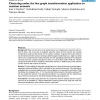Free Online Productivity Tools
i2Speak
i2Symbol
i2OCR
iTex2Img
iWeb2Print
iWeb2Shot
i2Type
iPdf2Split
iPdf2Merge
i2Bopomofo
i2Arabic
i2Style
i2Image
i2PDF
iLatex2Rtf
Sci2ools
BMCBI
2004
2004
Clustering under the line graph transformation: application to reaction network
Background: Many real networks can be understood as two complementary networks with two kind of nodes. This is the case of metabolic networks where the first network has chemical compounds as nodes and the second one has nodes as reactions. In general, the second network may be related to the first one by a technique called line graph transformation (i.e., edges in an initial network are transformed into nodes). Recently, the main topological properties of the metabolic networks have been properly described by means of a hierarchical model. While the chemical compound network has been classified as hierarchical network, a detailed study of the chemical reaction network had not been carried out. Results: We have applied the line graph transformation to a hierarchical network and the degreedependent clustering coefficient C(k) is calculated for the transformed network. C(k) indicates the probability that two nearest neighbours of a vertex of degree k are connected to each other. While
Related Content
| Added | 16 Dec 2010 |
| Updated | 16 Dec 2010 |
| Type | Journal |
| Year | 2004 |
| Where | BMCBI |
| Authors | Jose C. Nacher, Nobuhisa Ueda, Takuji Yamada, Minoru Kanehisa, Tatsuya Akutsu |
Comments (0)

